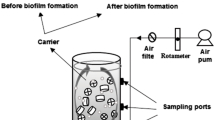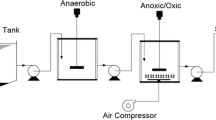Abstract
A novel suspended carrier with porous surface was firstly prepared by coating a sponge on the inside and outside of a hard polyethylene ring. Herein the effects of the sponge thickness (0, 2, 4, 6 mm) and pore size (17, 45, 85 pores per inch, ppi) on the performance of the start-up stage in moving bed biofilm reactor (MBBR) were investigated. The results indicated that the home-made carrier with the sponge thickness of 4 mm and the pore size of 45 ppi, defined as SC4-45, showed the best performance, which obtained high biomass concentration of 2,136.6 mg/L, oxygen uptake rate for COD of 150.1 mg O2/h and oxygen uptake rate for NH4 +-N of 17.4 mg O2/h. The DGGE profiles of the biofilms obtained in SC4-45 and a commercial carrier showed a similar community as the Dice similarity coefficients between two samples was 0.72. Furthermore, 16S rRNA gene sequence analysis reveals dominance of Sphaerotilus sp. and Aeromonas sp. in the community of both samples. Moreover, for the MBBR based on SC4-45, COD and NH4 +-N removal rates reached 99.5 ± 1.1 and 93.6 ± 2.3 % at the end of the start-up stage, much higher than those of the commercial carrier, 74.9 ± 2.7 and 40.0 ± 1.8 %, respectively. These indicated the novel carrier obtained a quick start-up.








Similar content being viewed by others
References
Daigger GT, Boltz JP (2011) Trickling filter and trickling filter-suspended growth process design and operation: a state-of-the-art review. Water Environ Res 83:388–404
Zhou L, Zhang Z, Jiang W, Guo W, Ngo HH, Meng X, Fan J, Zhao J, Xia S (2008) Effects of low-concentration Cr (VI) on the performance and the membrane fouling of a submerged membrane bioreactor in the treatment of municipal wastewater. Biofouling 30(1):105–114
Mixtli CP, Karim AA, Jesus Alberto MG, Marcela MT, Rolando TM, Luz MM, Marcelo V, Roberto PS (2012) Time and cost efficient biodegradation of diesel in a continuous-upflow packed bed biofilm reactor and effect of surfactant GAELE. J Chem Technol Biotechnol 87:1131–1140
Filho JLRP, Sader LT, Damianovic MHRZ, Foresti E, Silva EL (2010) Performance evaluation of packing materials in the removal of hydrogen sulfide in gas-phase biofilters: polyurethane foam, sugarcane bagasse, and coconut fiber. Chem Eng J 158:441–450
Pokhrel D, Hettiaratchi P, Patrick KS (2011) Methane diffusion coefficient in compost and soil-compost mixtures in gas phase biofilter. Chem Eng J 169:200–206
Sevillano X, Isasi JR, Penas FJ (2012) Performance of a fluidized-bed bioreactor with hydrogel biomass carrier under extremely low-nitrogen availability and effect of nitrogen amendments. J Chem Technol Biotechnol 87:402–409
Papadikis K, Gu S, Bridgwater AV (2010) A CFD approach on the effect of particle size on char entrainment in bubbling fluidized bed reactors. Biomass Bioenerg 34:21–29
Hu XB, Xu K, Wang Z, Ding LL, Ren HQ (2013) Characteristics of biofilm attaching to carriers in moving bed biofilm reactor used to treat vitamin C wastewater. Scanning 35:283–291
Tawfik A, El-Gohary F, Temmink H (2010) Treatment of domestic wastewater in an up-flow anaerobic sludge blanket reactor followed by moving bed biofilm reactor. Bioprocess Biosyst Eng 33:267–276
Currie JA, Harrison NR, Wang L, Jones MI, Brooks MS (2007) A preliminary study of processing seafood shells for eutrophication control. Asia Pac J Chem Eng 2:460–467
Gapes DJ, Keller J (2009) Impact of oxygen mass transfer on nitrification reactions in suspended carrier reactor biofilms. Process Biochem 44:43–53
Aygun A, Nas B, Berktay A (2008) Influence of high organic loading rates on COD removal and sludge production in moving bed biofilm reactor. Environ Eng Sci 25:1311–1316
Araujo MM Jr, Lermontov A, Araujo PL, Zaiat M (2013) Reduction of sludge generation by the addition of support material in a cyclic activated sludge system for municipal wastewater treatment. Bioresour Technol 143:483–489
Tawfik A, Badr N, Abu Taleb E, El-Senousy W (2012) Sewage treatment in an up-flow anaerobic sponge reactor followed by moving bed biofilm reactor based on polyurethane carrier material. Desalin Water Treat 37:350–358
Zhang S, Wang Y, He W, Wu M, Xing M, Yang J, Gao N, Pan M (2014) Impacts of temperature and nitrifying community on nitrification kinetics in a moving-bed biofilm reactor treating polluted raw water. Chem Eng J 236:242–250
Zekker I, Rikmann E, Tenno T, Saluste A, Tomingas M, Menert A, Loorits L, Lemmiksoo V, Tenno T (2012) Achieving nitritation and anammox enrichment in a single moving-bed biofilm reactor treating reject water. Environ Technol 33:703–710
Zekker I, Rikmann E, Tenno T, Lemmiksoo V, Menert A, Loorits L, Vabamäe P, Tomingas M, Tenno T (2012) Anammox enrichment from reject water on blank biofilm carriers and carriers containing nitrifying biomass: operation of two moving bed biofilm reactors (MBBR). Biodegradation 23:547–560
Zekker I, Rikmann E, Tenno T, Vabamäe P, Kroon K, Loorits L, Saluste A, Tenno T (2012) Effect of HCO3− concentration on anammox nitrogen removal rate in a moving bed biofilm reactor. Environ Technol 33:2263–2271
Nguyen TT, Ngo H, Guo W, Johnston A, Listowski A (2010) Effects of sponge size and type on the performance of an up-flow sponge bioreactor in primary treated sewage effluent treatment. Bioresour Technol 101:1416–1420
Garcia ML, Lapa KR, Foresti E, Zaiat M (2008) Effects of bed materials on the performance of an anaerobic sequencing batch biofilm reactor treating domestic sewage. J Environ Manag 88:1471–1477
Valdivia A, Gonzalez-Martinez S, Wilderer PA (2007) Biological nitrogen removal with three different SBBR. Water Sci Technol 55:245–254
Delatolla R, Berk D, Tufenkji N (2008) Rapid and reliable quantification of biofilm weight and nitrogen content of biofilm attached to polystyrene beads. Water Res 42:3082–3088
Zekker I, Kroon K, Rikmann E, Tenno T, Tomingas M, Vabamäe P, Vlaeminck SE, Tenno T (2012) Accelerating effect of hydroxylamine and hydrazine on nitrogen removal rate in moving bed biofilm reactor. Biodegradation 23:739–749
Bertin L, Lampis S, Todaro D, Scoma A, Vallini G, Marchetti L, Majone M, Fava F (2010) Anaerobic acidogenic digestion of olive mill wastewaters in biofilm reactors packed with ceramic filters or granular activated carbon. Water Res 44:4537–4549
Hille A, He M, Ochmann C, Neu TR, Horn H (2009) Application of two component biodegradable carriers in a particle-fixed biofilm airlift suspension reactor: development and structure of biofilms. Bioprocess Biosystems Eng 32:31–39
Odegaard H, Gisvold B, Strickland J (2000) The influence of carrier size and shape in the moving bed biofilm process. Water Sci Technol 41:383–391
Comett I, Gonzalez-Martinez S, Wilderer P (2004) Treatment of leachate from the anaerobic fermentation of solid wastes using two biofilm support media. Water Sci Technol 49:287–294
Rasmussen K, Lewandowski Z (1998) Microelectrode measurements of local mass transport rates in heterogeneous biofilms. Biotechnol Bioeng 59:302–309
Wei FS (2002) Monitoring and analysis method of water and wastewater. National Environmental Protection Agency, 4th edn. China Environmental Press, Beijing
Chaiwat R, Tawan L, Benedict L, Eakalak K (2010) Relationship between respirometric activity and community of entrapped nitrifying bacteria: implications for partial nitrification. Enzyme Microb Technol 46:229–236
Gorgensa JF, Van Zylb WH, Knoetze JH (2005) Reliability of methods for the determination of specific substrate consumption rates in batch culture. Biochem Eng J 25:109–112
Tan C, Ma F, Qiu S (2013) Impact of carbon to nitrogen ratio on nitrogen removal at a low oxygen concentration in a sequencing batch biofilm reactor. Water Sci Technol 67:612–618
Tay JH, Liu QS, Liu Y (2001) The effects of shear force on the formation, structure and metabolism of aerobic granules. Appl Microbiol Biotechnol 57:227–233
Beer DD, Stoodley P, Lewandowski Z (1996) Liquid flow and mass transport in heterogeneous biofilms. Water Res 30:2761–2765
Awong J, Bitton G, Koopman B (1985) ATP oxygen uptake rate and INT-dehydrogenase activity of actinomycete foams. Water Res 19:917–921
Nsabimana E, Belan A, Bohatier J (1999) Analysis at the genomospecies level of microbial populations changes in activated sludge: the case of Aeromonas. Water Res 34:1696–1704
Jassby D, Xiao Y, Schuler AJ (2014) Biomass density and filament length synergistically affect activated sludge settling: systematic quantification and modeling. Water Res 48(1):457–465
Fu B, Liao X, Lian R, Ding L, Xu K, Ren H (2011) COD removal from expanded granular sludge bed effluent using a moving bed biofilm reactor and their microbial community analysis. World J Microbiol Biotechnol 27:915–923
Chen Q, Qu L, Tong G, Ni J (2011) Simultaneous nutrients and carbon removal from low-strength domestic wastewater with an immobilized microorganism biological aerated filter. Water Sci Technol 63:885–890
Jiang F (2006) Biological properties of material and structure of suspended bio-carriers and cage-type bioreactor. Dissertation for Ph.D. South China University of Technology
Qiao XL, Chen QX, Zhang ZJ (2008) Comparative study of nitrification performances of immobilized cell fluidized bed reactor and contact oxidation biofilm reactor in treating high strength ammonia wastewater. J Chem Technol Biotechnol 83:84–90
Rahimi Y, Torabian A, Mehrdadi N, Shahmoradi B (2011) Simultaneous nitrification–denitrification and phosphorus removal in a fixed bed sequencing batch reactor (FBSBR). J Hazard Mater 185:852–857
Walters E, Hille A, He M, Ochmann C, Horn H (2009) Simultaneous nitrification/denitrification in a biofilm airlift suspension (BAS) reactor with biodegradable carrier material. Water Res 43:4461–4468
Gong L, Jun L, Yang Q, Wang S, Ma B, Peng Y (2012) Biomass characteristics and simultaneous nitrification–denitrification under long sludge retention time in an integrated reactor treating rural domestic sewage. Bioresour Technol 119:277–284
Yang S, Yang F, Fu Z, Lei R (2009) Comparison between a moving bed membrane bioreactor and a conventional membrane bioreactor on organic carbon and nitrogen removal. Bioresour Technol 100:2369–2374
Khan SJ, Ilyas S, Javid S, Visvanathan C, Jegatheesan V (2011) Performance of suspended and attached growth MBR systems in treating high strength synthetic wastewater. Bioresour Technol 102:5331–5336
Acknowledgments
This research was supported by Nature Science Foundations of China (20977117, 21107146), Nature Foundations of Guangdong Province (92510027501000005), Science and Technology Research Programs of Guangzhou City (2012J4300118) and Project of Education Bureau of Guangdong Province (cgzhzd1001), the Fundamental Research Funds for the Central Universities (121pgy20) and Innovative Talents Training Funding of Doctoral Students of Sun Yat-sen University and Scholarship Award for Excellent Doctoral Student Granted by Ministry of Education.
Author information
Authors and Affiliations
Corresponding authors
Rights and permissions
About this article
Cite this article
Chen, X., Kong, L., Wang, X. et al. Accelerated start-up of moving bed biofilm reactor by using a novel suspended carrier with porous surface. Bioprocess Biosyst Eng 38, 273–285 (2015). https://doi.org/10.1007/s00449-014-1266-6
Received:
Accepted:
Published:
Issue Date:
DOI: https://doi.org/10.1007/s00449-014-1266-6




